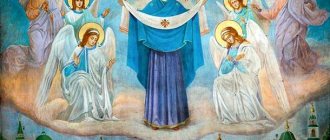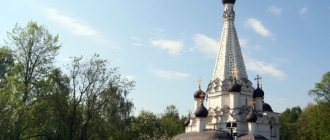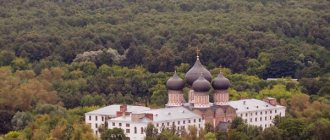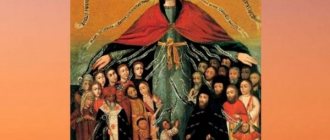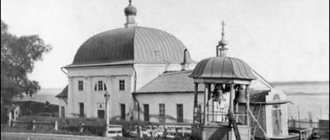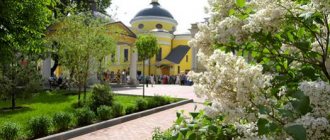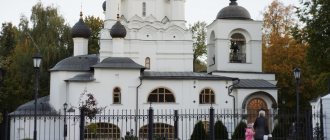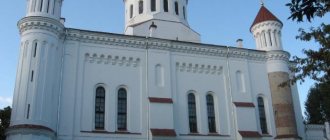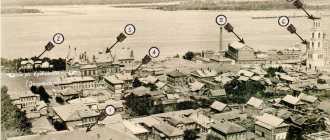For our ancestors, the Feast of the Intercession of the Most Holy Theotokos was one of the main autumn celebrations. According to the church calendar, it was celebrated in memory of the miraculous appearance of the Mother of God at the walls of Constantinople, cordoned off by the Saracens. Covering the city with her cloak, the Mother of God saved it from ruin. In Rus', Intercession Day was approved under Prince Andrei Bogolyubsky in 1164. The image of the Most Pure Virgin covering the people with her headdress fell in love with the Russian people.
In the Slavic calendar, Pokrov marked the end of agricultural work and the onset of winter. At this time, the first snow often fell, so the Intercession of the Virgin Mary was associated with the arrival of winter and with the snow cover of the earth. They said: “The cover covers the ground either with leaves or with snow.” At this time, spinners and weavers began their work. The girls began to sew their trousseau.
The history of the church holiday of the Intercession
The events preceding the appearance of this holiday, revered in Russia, took place in distant Constantinople in 910. The city was under siege. Exhausted residents gathered in the Blachernae temple to pray to the Lord for the liberation of Constantinople from the Saracens. At this time, the blessed holy fool Andrew came to the church with his disciple Epiphanius, the future patriarch of Constantinople. In the Blachernae Church there was a robe of the Mother of God, Her belt and veil.
The whole night was spent in fervent prayer, and in the morning Saint Andrew saw the Mother of God praying over the believers along with the angels, accompanied by the Apostle John the Theologian and the Prophet John the Baptist. The Queen of Heaven shone brighter than the sun. The Mother of God knelt down at the altar and tearfully prayed for a long time for the salvation of Christians. Having prayed, the Mother of God took off her veil, sparkling like lightning, from her head and spread it over the believers.
Blessed Andrew and Epiphanius watched the miracle taking place with reverent awe, until the Mother of God became invisible. After this memorable service, the enemies retreated from the walls of Constantinople, and the day of the appearance of the Queen of Heaven in the Blachernae Church served as the beginning of the celebration of the Protection of the Mother of God in the Russian Orthodox Church.
For almost a thousand years, this holiday was celebrated only in Russia. In Greece, where the memorable event took place, it was forgotten. The celebration of the Intercession in the Greek Church began in the 20th century.
The Holy Synod decided to hold a solemn service on October 28, according to the new style - October 14.
Prayers before the icon
The day of celebration of the icon is October 14th.
Troparion, tone 4
Today, faithful people, we brightly celebrate, / overshadowed by Your coming, O Mother of God, / and looking to Your most pure image, we tenderly say: / Cover us with Your honorable Protection / and deliver us from all evil, / praying to Your Son, Christ our God, // save our souls.
Translation: On this day, we, faithful people, solemnly celebrate, overshadowed by Your coming, Mother of God; and, looking at Your most pure image, we cry with tenderness: “Cover us with Your sacred Veil and deliver us from all evil, begging Your Son, Christ our God, to save our souls.”
Kontakion, tone 3
The Virgin stands today in the church / and from the faces of the saints invisibly prays to God for us, / Angels and bishops bow down, / while the apostles and prophets rejoice // for our sake the Mother of God prays to the Eternal God.
Translation: Today the Virgin stands in the temple and, with a host of saints, invisibly prays to God for us. The angels and bishops worship, while the apostles and prophets rejoice: for the Mother of God prays for us to the Eternal God.
First prayer
Oh, Most Holy Virgin, Mother of the Lord of the highest powers, Heaven and earth Queen, our city and country, Almighty Intercessor! Accept this song of praise and thanksgiving from us, Thy unworthy servants, and lift up our prayers to the Throne of God of Thy Son, that He may be merciful to our iniquities, and add His grace to those who honor Your all-honorable name and with faith and love those who worship Your miraculous image. For we are not worthy of mercy from Him, unless You propitiate Him for us, O Lady, for all things are possible for You from Him. For this reason we resort to You, as to our undoubted and speedy Intercessor: hear us praying to You, overshadow us with Your all-powerful protection, and ask God for Your Son: to be our shepherd We give zeal and vigilance for souls, the city ruler wisdom and strength, we judge truth and impartiality , a mentor is reason and humility, a spouse is love and harmony, a child is obedience, patience to those who are offended, fear of God to those who are offended, complacency to those who mourn, abstinence to those who rejoice, but to all of us the spirit of reason and piety, spirit mercy and meekness, the spirit of purity and truth. To her, Most Holy Lady, have mercy on Your weak people; Gather those who are scattered, guide those who have gone astray, support old age, bring up young chastity, raise children, and look upon us all with the gaze of your merciful intercession, raise us up from the depths of sin and enlighten us Our heart's eyes are to the sight of salvation, be merciful to us here and there, in the land of earthly coming and at the terrible judgment of Your Son; Having ceased in faith and repentance from this life, our fathers and brothers created eternal life with the Angels and with all the saints. For you are, Lady, the Glory of Heaven and the Hope of the earth, You, according to God, are our Hope and Intercessor of all who flow to You with faith. We pray to You, and to You, as the Almighty Helper, we commit ourselves and each other and our whole life, now and ever and unto the ages of ages. Amen.
Second prayer
My Most Blessed Queen, my Most Holy Hope, friend of the orphaned and strange, Intercessor, protection of the needy and embittered, see my misfortune, see my sorrow: overcome temptation from everywhere I am, but there is no intercessor. You yourself help me as I am weak, feed me as I am strange, guide me as I am lost, heal and save me as I am hopeless. I have no other help, no other intercession, no consolation except You, O Mother of all who mourn and are burdened! Look upon me, a sinner and in the bitterness of my being, and cover me with Your most holy omophorion, that I may be delivered from the evils that have befallen me, and I will praise Your praised name. Amen.
( 3 ratings, average: 5.00 out of 5)
Description and meaning in Orthodoxy
In Rus', this holiday appeared in the 12th century during the reign of Prince Andrei Bogolyubsky. Then the Volga Bulgars attacked North-Eastern Rus'. The inhabitants of Suzdal, Vladimir and Murom suffered from their raids. For the war with the Bulgars, Prince Andrei called soldiers from neighboring lands under his banner.
The miraculous icons of the All-Merciful Savior and the Mother of God of Vladimir were taken on the campaign. With holy intercession, the Russian squad quickly defeated the Bulgars. The prince's army was almost unharmed, and he saw this as a real miracle.
Returning home, Saint Andrei Bogolyubsky, by his decree, approved a new Orthodox holiday in honor of the Intercession of the Most Holy Theotokos. It means that the Queen of Heaven protects us with her prayer cover.
Orthodox celebration traditions
The Russian Orthodox Church considers the Most Holy Theotokos to be its main patroness. She tirelessly asks Her Son and Our Lord for the salvation of living and departed Christians.
Every year on October 14, all Orthodox churches hold festive services in honor of the Intercession of the Most Holy Theotokos. On this day, believers strive to visit churches and pray to the Queen of Heaven, ask for help or give thanks.
The Icon of the Intercession of the Mother of God is prayed to for various needs. She responds to the sincere requests of believers to grant healing from illnesses and solve material and housing problems. They ask the Mother of God to protect peace and tranquility in the family, the girls pray for a speedy marriage and a happy marriage.
Orthodox people believed that the presence of the icon of the Intercession of the Most Holy Theotokos in the house would protect the home from fire. The peasants prayed in front of the holy image for a rich harvest and good weather.
Customs
During this period, active preparations were underway for the coming winter. As a rule, men collected firewood and insulated houses, while women spun, sewed and weaved. People said: “Mend your fur coat before the Intercession - otherwise there will be no warmth,” “Get some warmth before the Intercession.”
The cattle were released into the field for the last time. Usually she was fed hay from the last sheaf of the current harvest.
Veil is the last day of collecting mushrooms: saffron milk caps and bunches. Our ancestors had such a custom: on Pokrov it was necessary to go into the forest and pick mushrooms, at least a little. The mushrooms were dried and put away in a secluded place. People believed that this attracted wealth to the house.
At the same time, it was customary to burn old clothes or clothes of a sick person. It was believed that then all diseases would be spared.
Another custom that protected children from illnesses was dousing with water . At the same time, the children were taken to the threshold of a house or street and doused with water through a sieve or sieve. The ritual was performed by the eldest woman in the family.
Iconography
The most ancient images of the Intercession, which were preserved on the Golden Suzdal Gate. The image of the Mother of God here is depicted in profile, and an omophorion extends over her. The images on the icons of the Intercession of the Mother of God are based on the biography of Blessed Andrei the Fool, from whom everyone learned about the appearance of the Mother of God. There are two traditions of icon painting:
- “Suzdal” - on these icons the Mother of God, extending her omophorion over those praying, is depicted in front of the temple, which represents the outline of the Blachernae Church, where the miraculous phenomenon took place.
- “Novgorod” - here the Mother of God is depicted praying in the temple together with other believers. She stands on a cloud above the closed Royal Doors. A red cover is spread over the Mother of God, which is carefully held on both sides by angels floating in the air.
Suzdal iconography is associated with the first Bogolyubskaya icon of the Mother of God. It was from it that lists of miraculous icons were made, which were distributed to numerous churches in Russia. The earliest surviving Novgorod icon of the Intercession of the Virgin Mary is an image from the ancient Zverin Monastery. The composition of the icon is symmetrical. The images of its parts are balanced. In the center is the image of the Mother of God, to the right and left are the participants in the great event.
Later, these two traditions of depicting the great event began to unite. Starting from the 17th century, the composition of icons changed. They depict the solemn procession of the Mother of God, accompanied by saints and angels to the Throne of the Savior.
Russian icon painters reverently and carefully depicted not only important details from chronicle sources, but also images of saints. On the icons of the Intercession of the Virgin Mary, the Apostle John the Theologian and the Prophet John the Baptist are always present. They are located to the left of the image of the Mother of God. On the right you can see Andrei the Fool, pointing out a miraculous vision to his student Epiphanius.
There are revered icons in honor of the Feast of the Intercession of the Virgin Mary in many urban and rural churches.
About dreams
Dreams with a clear storyline should be interpreted. The dream in which the Mother of God appeared is considered especially significant. In a dream, the Mother of God:
- smiles - for joyful events
- crying - to sadness and sadness
- closes his eyes - a person has many enemies
- talks - in reality there are many challenges ahead, but you will be able to cope with them
- descends from the sky - your cherished wish will soon come true
In the hands of the Holy Veil - a conversation with an ill-wisher awaits.
Temples in Rus'
The first church dedicated to the Feast of the Intercession of the Most Holy Theotokos was erected by Andrei Bogolyubsky himself. The monument of ancient Russian architecture was erected at the confluence of the Nerl and Klyazma rivers in the Vladimir region. It rises in the middle of a huge meadow on a man-made hill, which becomes a small island in the spring when the water in the rivers rises.
After the victorious capture of Kazan, Tsar Ivan the Terrible ordered the foundation of the Intercession Cathedral, which later became St. Basil's Cathedral. In the autumn of 1554, a temporary wooden temple was built. The stone cathedral was built over the course of 6 years, and until 1600 it was the tallest building in Moscow.
Many churches were consecrated in honor of the Intercession of the Virgin Mary. The most famous is the Intercession Cathedral at the Rogozhskoye cemetery, built at the end of the 18th century. It was conceived as a five-domed temple of quite impressive size, but, by order of Empress Catherine II, the project was changed. As a result, the cathedral was left with one chapter, and the height of the building was reduced. Until the Cathedral of Christ the Savior was restored, the Intercession Cathedral was considered the largest Moscow church.
The holiday is also highly revered by the Old Believer Church. The holiday of the Intercession is one of the most revered in Russia. Almost every city has temples and cathedrals consecrated in his honor. In Moscow alone there are about a hundred of them.
Divine service
Chants dedicated to the Intercession are included in all ancient Russian stichirari. This holiday was first mentioned in Prologues and collections of instructive texts from the late 12th – early 13th centuries. The Intercession began to be celebrated throughout Rus' only in the 15th century. The Great Menaions, compiled by Saint Macarius, Metropolitan of Moscow, contain words of praise for the Feast of the Intercession of the Theotokos.
All church hymns dedicated to the holiday are imbued with a feeling of gratitude and joy. The Mother of God is the great intercessor of the Russian people before the Lord. Her holy prayers protect Orthodox people from misfortunes and evil. In the festive troparion, believers ask the Mother of God to cover everyone with her honest cover and pray to God for the salvation of souls.
Used materials
- Menaion-October, ed. Moscow Patriarchate, p. 4, 10, 14, 43 (prayers):
[1] “Μνήμη Ἁγίας Σκέπης τῆς Ὑπεραγίας Θεοτόκου”, page of the Greek site ΜΕΓΑΣ ΣΥΝΑΞΑΡΙΣΤΗΣ (Big month)
, according to the book: Αγαθάγγελος (Χαραμαντίδης), Επ.
Φαναρίου, ΜΕΓΑΣ ΣΥΝΑΞΑΡΙΣΤΗΣ
(Bishop of Phanaria Agathangel, “Synaxarion of the Orthodox Church”), Αποστολικής Διακονίας τη ς Εκκλησίας της Ελλάδος, .
[2] See: “Okha Day in Greece”, Calend.RU
, .
[3] Translation by Natalia Bakhareva. “Troparia and kontakion of Hellenstia. Octovrius (1 - 15)". // Blog on LiveJournal of user Natalia Bakhareva -
[4] In modern publications, instead of the word “honest,” the word “saint” is often used here, which does not correspond to pre-revolutionary liturgical books. For the correct text, see, for example, on the page of the portal Pravoslavie.RU
: .
Folk traditions and signs
Mid-October in Rus' was considered a transition period from autumn to winter. By this time, the peasants were trying to finish all field work, prepare livestock for the winter, and stockpile food. The harsh frosty season had already begun. The stoves began to burn, the huts were carefully caulked.
On the day of the Intercession, the last sheaf, the “reaper,” was given to the cattle. It was prepared by the whole family and stored until the holiday in the front corner of the hut. It was believed that this sheaf would protect animals from harm and give them strength to survive the harsh winter.
The Feast of the Intercession of the Virgin Mary is a favorable time for weddings. As the popular saying goes: “Pokrov-holiday, cover the earth with snow, and my head with a crown.” Every young girl dreamed of getting married at this time. After all, the Mother of God herself was the patroness on this significant day. They prayed to her and lit candles in front of her icon in churches. It was believed that the girl who was the first to light a candle to the Virgin Mary would be the first to get married.
“Pokrovsky” day is rich in folk signs. The peasants determined by it. What kind of winter will it be? The first snow, which fell on October 14, foreshadowed the early onset of winter. And vice versa, it will be soft and snowless if rain falls on the Pokrov. The flight of cranes to warmer regions on this day is a sure sign of an early and cold winter.
Maple and birch trees have not lost their leaves by mid-October - expect severe frosts. The upcoming winter weather was also determined using a weather vane. Wind from the north - cold winter, from the south - warm. Frost on Pokrov has a symbolic meaning. It covers the earth, just as the Most Holy Theotokos protects all Orthodox Christians with her omophorion.
